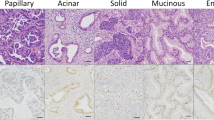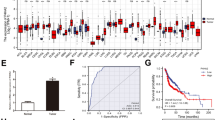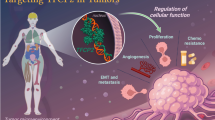Abstract
Homeobox genes regulate sets of genes that determine cellular fates in embryonic morphogenesis and maintenance of adult tissue architecture by regulating cellular motility and cell–cell interactions. Our previous studies showed that a specific member, HOXD3, when overexpressed, enhanced cell motility and invasiveness of human lung cancer A549 cells (Hamada et al. Int. J. Cancer 2001; 93: 516–25 [19]). In the present study, we investigated the roles of HOXD3 in motile and invasive behavior of human malignant melanoma cells. Of seven melanoma cell lines examined here, six cell lines expressed the HOXD3 gene, whereas normal melanocytes did not. We transduced the HOXD3-antisense gene expression vector into two cell lines (A375M and MMIV). The cell transduced with the HOXD3-antisense gene showed reduced in vitro invasion of Matrigel. The transduction of the HOXD3-antisense gene also decreased cell spreading, haptotactic activity to vitronectin and laminin-1, and phagokinetic activity. To find the difference of gene expression between the HOXD3-antisense-transduced A375M cells and the control A375MNeo2 cells, we carried out cDNA microarray analysis. The results of the microarray analysis indicated that the increased expression of cdc42-interacting protein 4, KIAA0554 and tropomyosin 1, which are all associated with the cytoskeletal system, may be involved in the reduction of motile and invasive activity by the HOXD3-antisense gene transduction.
Similar content being viewed by others
References
Deschamps J, Meijlink F. Mammalian homeobox genes in normal development and neoplasia. Crit Rev Oncog 1992; 3: 117–73.
Mavilio F. Regulation of vertebrate homeobox-containing genes by morphogens. Eur J Biochem 1993; 212: 273–88.
Gehring WJ, Hiromi Y. Homeotic genes and the homeobox. Annu Rev Genet 1986; 20: 147–73.
Graham A, Papalopulu N, Krumlauf R. The murine and Drosophila homeobox gene complexes have common features of organization and expression. Cell 1989; 57: 367–78.
Apiou F, Flagiello D, Cillo C et al. Fine mapping of human HOX gene clusters. Cytogenet Cell Genet 1996; 73: 114–5.
Mark M, Rijli FM, Chambon P. Homeobox genes in embryogenesis and pathogenesis Pediatr Res 1997; 42: 421–9.
Cillo C, Barba P, Freschi G et al. HOX gene expression in normal and neoplastic human kidney. Int J Cancel 1992; 51: 892–7.
Cillo C. HOX genes in human cancers. Invasion Metastasis 1994–95; 14: 38–49.
Borrow J, Stanton VP Jr, Andresen JM et al. The translocation t(8;16)(p11;p13) of acute mycloid leukaemia fuses a putative acetyl-transferase to the CREB-binding protein. Nat Genet 1996; 14: 33–41.
Nakamura T, Largaespada DA, Lee MP et al. fusion of the nucleoporin gene NUP98 to HOXA9 by the chromosome translocation t(7;11)(p15;p15) in human myeloid leukaemia. Nat Genet 1996; 12: 154–8.
Nakamura T, Largaespada DA, Shaughnessy JD Jr et al. Cooperative activation of Hoxa and Pbx1-related genes in murine myeloid leukaemias. Nat Genet 1996; 12: 149–53.
Cillo C, Faiella A, Cantile M et al. Homeobox genes and cancel. Exp Cell Res 1999; 248: 1–9.
De Vita G, Barba P, Odartchenko N et al. Expression of homeobox-containing genes in primary and metastatic colorectal cancel. Eur J Cancel 1993; 29A: 887–93.
Tiberio C, Barba P, Magli MC et al. HOX gene expression in human small-cell lung cancers xenografted into nude mice. Int J Cancel 1994; 58: 608–15.
Alami Y, Castronovo V, Belotti D et al. HOXC5 and HOXC8 expression are selectively turned on in human cervical cancel cells compared to normal keratinocytes. Biochem Biophys Res Commun 1999; 257: 738–45.
Calvo R, West J, Franklin W et al. Altered HOX and WNT7A expression in human lung cancel. Proc Natl Acad Sci USA 2000; 97: 12776–81.
Taniguchi Y, Fujii A, Moriuchi T. Cloning and sequencing of the human homeobox gene HOX4A. Biochim Biophys Acta 1992; 1132: 332–4.
Taniguchi Y, Komatsu N, Moriuchi T. Overexpression of the HOX4A (HOXD3) homeobox gene in human erythroleukemia HEL cells results in altered adhesive properties. Blood 1995; 85: 2786–94.
Hamada Ji, Omatsu T, Okada F et al. Overexpression of homeobox gene HOXD3 induces coordinate expression of metastasis-related genes in human lung cancer cells. Int J Cancer 2001; 93: 516–25.
Boudreau N, Andrews C, Srebrow A. Induction of the angiogenic phenotype by Hox D3. J Cell Biol 1997; 139: 257–64.
Rigel, DS. Epidemiology and prognostic factors in malignant melanoma. Ann Plast Surg 1992; 28: 7–8.
Sauter ER, Herlyn M. Molecular biology of human melanoma development and progression. Mol Carcinog 1998; 23: 132–43.
Kleinman HK, McGarvey ML, Hassell JR et al. Basement membrane complexes with biological activity. Biochemistry 1986; 25: 312–8.
Aspenstrom P. A Cdc42 target protein with homology to the nonkinase domain of FER has a potential role in regulating the actin cytoskeleton. Curr Biol 1997; 7: 479–87.
Tian L, Nelson DL, Stewart DM. Cdc42-interacting protein 4 mediates binding of the Wiskott-Aldrich syndrome protein to microtubules. J Biol Chem 2000; 275: 7854–61.
MacLeod AR, Houlker C, Reinach FC et al. A muscle-type tropomyosin in human fibroblasts: Evidence for expression by an alternative RNA splicing mechanism. Proc Natl Acad Sci USA 1985; 82: 7835–9.
Prasad GL, Meissner S, Sheer DG et al. A cDNA encoding a muscle-type tropomyosin cloned from a human epithelial cell line: Identity with human fibroblast tropomyosin TM1. Biochem Biophys Res Commun 1991; 177: 1068–75.
Hendricks M, Weintraub H. Tropomyosin is decreased in transformed cells. Proc Natl Acad Sci USA 1981; 78: 5633–7.
Prasad GL, Fuldner RA, Cooper HL. Expression of transduced tropomyosin 1 cDNA suppresses neoplastic growth of cells transformed by the ras oncogene. Proc Natl Acad Sci USA 1993; 90: 7039–43.
Takenaga K, Nakamura Y, Sakiyama S. Differential expression of a tropomyosin isoform in low-and high-metastatic Lewis lung carcinoma cells. Mol Cell Biol 1988; 8: 3934–7.
Author information
Authors and Affiliations
Rights and permissions
About this article
Cite this article
Okubo, Y., Hamada, Ji., Takahashi, Y. et al. Transduction of HOXD3-antisense into human melanoma cells results in decreased invasive and motile activities. Clin Exp Metastasis 19, 503–512 (2002). https://doi.org/10.1023/A:1020346211686
Issue Date:
DOI: https://doi.org/10.1023/A:1020346211686




